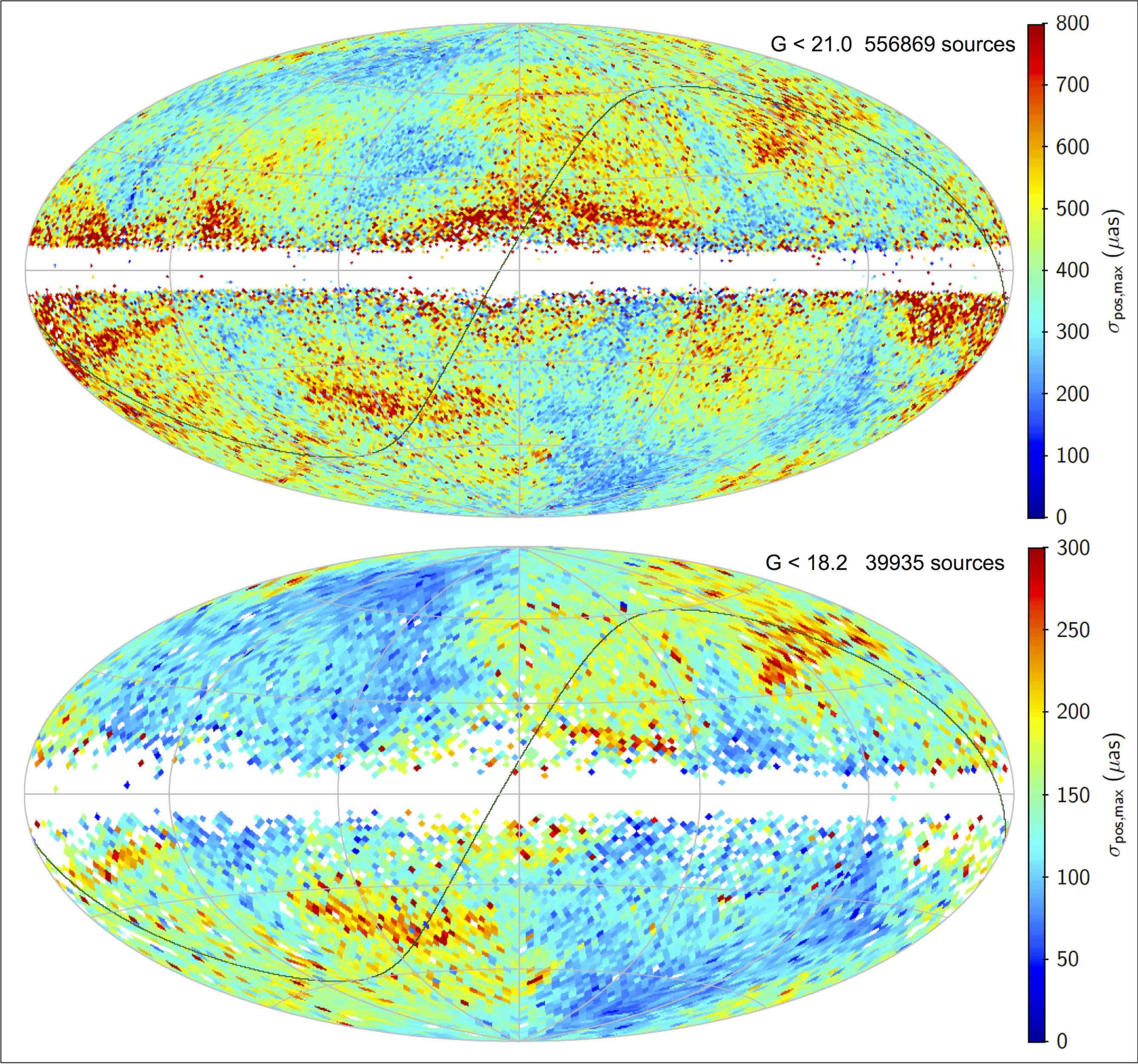Gaia Celestial Reference Frame 2 - Gaia
The Gaia Celestial Reference Frame
The all-sky distributions give the median of the formal position uncertainty for the position of the quasars materialising the Gaia Celestial Reference Frame (Gaia-CRF2). The frame is constructed from the astrometric solution built on 22 month of Gaia data, by selecting quasars, the most distant extragalactic sources known to date. According to the principles of ICRS, the Gaia astrometric solution is constructed using the constraint that those quasars on average show no global rotation. The maps give the median of the uncertainties of all the sources found in each pixel, about 0.9 x 0.9 deg2 for the upper panel for all the 556,869 sources and 1.8 x 1.8 deg2 for the lower panel restricted to the sources brighter than G = 18.2 and corresponding to an average of one source per square degree. For this subset the Gaia sky average position uncertainty is less than 0.2 milli-arcsecond.
The Gaia Celestial Reference Frame (Gaia-CRF2) is realised by the accurate positions of 556,869 quasars. This is the first realisation of a non-rotating full sky optical reference frame meeting the ICRS prescriptions, i.e. built only on extragalactic sources constrained to have no global rotation. With a mean density of more than 10 quasars per square degree it represents a more than 100-fold increase in the number of objects from the current realisation at radio wavelengths.
The formal position uncertainty is shown in this sky distribution using a Hammer-Aitoff projection in galactic coordinates with zero longitude at the centre and increasing longitude from right to left. The solid line is the trace of the ecliptic. The uncertainty is computed by combining the uncertainty in both coordinates and takes the correlation into account. The map gives for each pixel the median of the uncertainty of all the sources found in this particular area.
The complete sample shown in the upper panel has a sky average median magnitude of 19.6. The overall median position uncertainty is about 0.5 milli-arcsecond with variation from 0.2 to 0.7 milli-arcsecond according to location. This scatter is primarily caused by the properties of the Gaia scanning law. The lower panel is limited to the sample with G magnitudes below 18.2 so that there is on the average one source per square degree outside the galactic plane. The median of the position uncertainty is about 0.15 milli-arcsecond, ranging from below 0.1 milli-arcsecond at ecliptic latitudes above 45 degrees, to 0.2 milli-arcsecond in the vicinity of the ecliptic.
Credits: ESA/Gaia/DPAC, François Mignard (Observatoire de la Côte d'Azur, Nice), Sergei Klioner (Lohrmann-Observatorium, Dresden), and the co-authors of the paper "Gaia Data Release 2: The celestial reference frame (Gaia-CRF2)"
Published 25 April 2018
- Removed a total of (4) style text-align:center;
- Removed a total of (3) style text-align:justify;
Image of the Week Archive
- Removed a total of (1) border attribute.
- Removed a total of (1) cellpadding attribute.
- Removed a total of (1) cellspacing attribute.








































 Sign in
Sign in
 Science & Technology
Science & Technology
